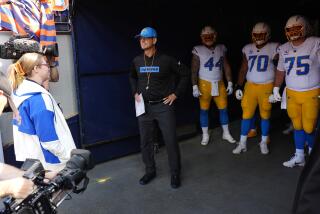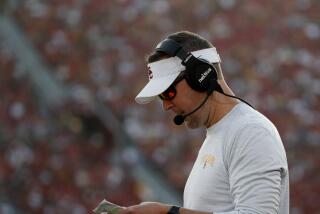Fitness Blamed in Some Instances
Modern football players might be more susceptible to dehydration because they are in better shape, two former NFL coaches said.
Arizona Coach John Mackovic and USC Coach Pete Carroll, with decades of professional experience between them, spoke about the potential dangers of training camp at the Pacific 10 Conference’s annual media day Wednesday at the Sheraton Gateway Hotel.
“It’s so different today,” said Mackovic, who coached the Kansas City Chiefs in the mid-1980s. “Players used to come to camp to get in shape. Now everyone is expected to report in good condition.”
That means competition starts at a high level from the first day of summer practice.
“We’ve taken guys so far, it’s like you can’t wear them down,” Carroll said.
During his years in the NFL, where he coached the New York Jets and the New England Patriots, Carroll saw players--especially the “heavy sweaters”--being given intravenous fluids every day in camp.
Players won’t always admit to feeling bad. Carroll says the most important thing is for coaches and trainers to watch for players who stop sweating and become lightheaded.
“It’s scary,” he said. “You just don’t want to miss the signs and, before you know it, there’s a life-threatening situation.”
With his team starting practice in Tucson this month, Mackovic plans to take extra precautions. There will be shorter practices to begin with and practices in the evening when the temperature cools to 80 degrees. A tent will stand beside the field.
“There will be built-in rest periods,” Mackovic said. “The players can literally lay down and have Popsicles and cold towels to get their body temperature down.”
But not everyone at the Pac-10 event was so concerned.
“There are a million ways a man can die,” Oregon State tailback Ken Simonton said. “You can’t worry about it.”
(BEGIN TEXT OF INFOBOX / INFOGRAPHIC)
The Effects of Extreme Heat
* The Index
High humidity makes the heat feel even hotter--and become more dangerous. A temperature of 90 degrees with 80% humidity results in a heat index of 113. Heat stress, cramps or heat exhaustion are likely when the index goes above 105.
* The Signs
Heat-related illnesses include heat stress and heat exhaustion. Signs of heat stress include cramps and confusion. Excessive loss of water and salt from the body causes heat exhaustion and symptoms of paleness, fatigue, faintness, nausea, headaches, rapid breathing and pulse. Heatstroke occurs when these symptoms are left untreated and the body starts to shut down.
For more on the effects of extreme heat, see “The Hazards of Heat” on A20
More to Read
Go beyond the scoreboard
Get the latest on L.A.'s teams in the daily Sports Report newsletter.
You may occasionally receive promotional content from the Los Angeles Times.











